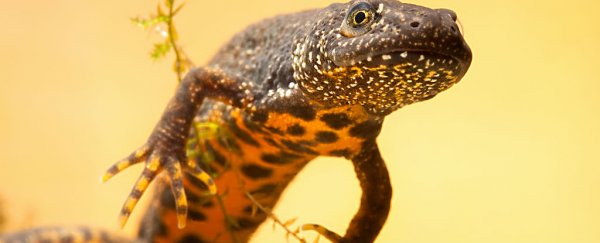Pretend you're a newt for a second. You're going about your day, doing what newts do. Then, out of nowhere, some nosey predator picks you up and rips off your legs. Though you manage to get away, your situation seems pretty dire, right? Well, if you were a mammal, yes, but for a newt, this is just another afternoon because, unlike any other creature in the world, newts have the unique ability to regenerate large amounts of tissue well into adulthood.
The good news for us humans is that researchers now finally understand the biological mechanism that drives this super-powered ability, and it could one day help us regenerate our limbs too.
First, let's discuss, in brief, the differences between how mammals and newts heal themselves. If you were to sustain an injury, big or small, your body would seal up the wound with a scab and then cover it with scar tissue. Though this technique works well for cuts and other small injuries, it's no use to someone who has just severed a limb.
Newt cells, on the other hand, can seamlessly rebuild any damaged tissue - from eyeballs to spinal cords - without scars or scabs, and for a long time, the processes at work have eluded us. Until now.
Researchers from the University of Tsukuba in Japan and the University of Dayton in the US were able to pin-point two different cell types that are responsible for this regeneration: skeletal muscle fibre cells (SMFCs) and muscle stem/progenitor cells (MPCs). While SMFCs actively make up skeletal muscles, MPCs are the dormant predecessors of muscle fibre cells, but they can be triggered to transform into muscle fibre cells with the right stimuli.
With that knowledge in hand, the researchers decided to investigate what each of these cells did during a regeneration event.
First, they inserted a gene into newt embryos that causes a particular protein to fluoresce red when SMFCs and MPCs are active. They then allowed their newts to reach either the swimming larval stage (at three months old), or the metamorphosed juvenile stage (16 months old).
At this point, the researchers proceeded to amputate a limb from each (don't worry, the newts were under anaesthesia for the procedure), before observing the activity of SMFCs and MPCs as limbs were regrown.
In the end, they found that MPCs were mostly responsible for regeneration in the younger group - not SMFCs. "These experiments showed that the new muscle in larval newt regeneration tissue is primarily derived from muscle stem/progenitor cells (MPCs), not skeletal muscle fibre cells (SMFCs)," the University of Tsukuba team reports.
Interestingly, when they observed the activity of the skeletal muscle fibre cells (SMFCs) in the stumps of the older newts, the researchers discovered that they temporarily regressed to a more primitive state - they become 'dedifferentiated'. They then appeared to re-enter the cell cycle, proliferate, and produce more muscle cells.
"Larval newts use stem/progenitor cells (SMFCs) for new muscle in a regenerated limb, while metamorphosed newts recruit muscle fibre cells (MPCs) in the stump for the same purpose," explains one of the Japanese researchers, Hibiki Tanaka.
"The newt switches the cellular mechanism for limb regeneration from a stem/progenitor-based mechanism (larval mode) to a dedifferentiation-based one (adult mode) as it transits beyond metamorphosis," his colleague, Chikafumi Chiba, adds.
So now that researchers have a basic understanding of the mechanisms at play in this incredibly rare (and valuable) ability, can humans get in on that too? Well, there's obviously still a lot of work to be done before we fully understand the nuances of the discovery, but the team is hopeful that this initial find will help us figure out how regeneration could be possible in other species in the future.
The team's full report was published in Nature Communications.
